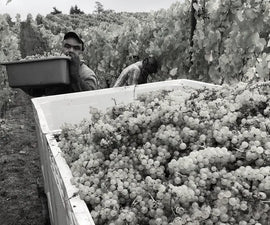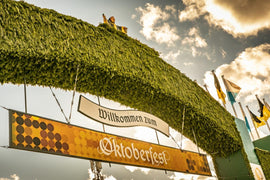Unlike the Spanish Inquisition, everyone expects the Italian Wine Club. Our chief weapons are clarity and regularity - join the club; get 2 Italian wines every month - along with pretty labels, tasty recipes, and an almost fanatical devotion to finding the best and most interesting bottles from the Bel Paese. That’s the deal, and we take it very seriously. But every institution, no matter how venerable, needs a periodic kick in the pants to keep things interesting, heresy can be liberating and, more to this month’s point: there is just no way to grok the totality of Italian wine without leaving Italy at least once. So while the peninsula will definitely remain the protagonist of (almost) every future installment, for September we are headed elsewhere. Or staying home, if you like – because arguably the best place to taste Italian viticulture’s profound influence on the rest of the winemaking world is right here in California.
French varietals like Chardonnay and Pinot Noir might be more ubiquitous, but the Boot’s print is evident all over the Golden State. Some of the largest producers in the world, famous names like Gallo, Robert Mondavi, Seghesio and Sutter Home, were founded by Italian immigrants - at one point in the 1960’s over half the cooperages in California were controlled by Cali-Italian concerns. Today, Italian Americans still play a very significant role, owning or managing 15 percent of the wineries, including three of the largest and ten of the oldest. Though Zinfandel, the California Heritage Grape, is thought to have been brought over from Vienna Austria’s Imperial Nursery, it is genetically identical to the Puglian varietal Primitivo, and Italian immigrants were central to its planting and popularity across the state.
As soon as Italians began journeying to the US in significant numbers, spurred by poverty at home and gold rush out west, they were farming land, planting grapes, and making wine. Between 1880 and 1924, some four million emigrated to the USA, many of them young single men, most of whom found work in agriculture. One of their largest employers was Andrea Sbapboro, himself a native of Genoa who had arrived, aged twelve, in 1850. In 1881, he formed the Italian-Swiss Colony, consisting of 1,500 acres in northern Sonoma County near Cloverdale, around the village of Asti (named for the Piedmontese wine-making commune.) Spapboro initially intended the venture to be a combination business-social philanthropy concern that would employ (and eventually provide ownership stakes to) the large local Italian immigrant labor pool. While the latter part of the project never quite took off, the business end proved quite successful, planting grapes as diverse as Zinfandel, Carignane, Mataro, Barbera, Cabernet, Pinot Noir, Riesling, Pinot and Sauvignon Blanc, modernizing production and distribution enough to weather phylloxera and market fluctuations, and arriving around the turn of the century as the biggest producer in a California wine industry that was selling its product all over the world.
Much less famous, but more important for our purposes (and arguably more representative of this general migration) is Luigi A. LePiane, who came to California from Piane Crati in Calabria (our destination last month) in 1885 and opened up a General Store and Butchery east of Monterey Bay. An oenophile, he started a small winery under his own name in Holister, California right after the repeal of Prohibition in 1935, but sadly passed away shortly after. Three generations later Alison Thomson grew up in Napa hearing remembrances of her great-grandfather, and under the impression he made wine only for his personal consumption. After studying in Italy and catching the wine bug, she attended UC Davis, studying viticulture rather than eonenology as most aspiring vintners do so she could become familiar with plants, soil and vineyards first, and learn winemaking via direct experience in the cellar. To that end, she worked at Ettore Germano in Piedmont and Sine Qua Non, Palmina winery (which specializes in Italian varietals) and Samsara in California. Along the way she discovered that her great-grandfather Luigi had actually been a well-regarded local winemaker; she was even able to locate the blueprints, paperwork, and bookkeeping related to his operation.
So when Alison started her own winery, dedicated to Italian grapes and Californian terroir, she named it after her ancestor and the dream he lived just long enough to get off the ground. Her first release was 2013 Nebbiolo which, aged properly, came out in 2017. I came across the 2016 vintage not long ago, and was blown away; calling it the best California Nebbiolo I’ve had seems like faint praise in one sense (there aren’t that many), but it is also accurate. That bottling is a little out of the IWC price range, but fortunately everything I’ve tried from LePiane has been great (we also carry the Rose of Nebbiolo), so this month we’ve got her lovely skin contact Malvasia Bianca and La Gaviota blend of Nebbiolo and Barbera, a fresh, lively and immediately beguiling red that will also age gracefully. Next month we will be back to Italy but in September - California Wine Month and the middle of harvest season, as it happens - it feels appropriate to toast the unexpected places Italian wine can take us.
|
L.A. Lepiane Malvasia Bianca 2020 |
|
|
Region: Happy Canyon, Santa Barbara, California |
About the Winemaker Alison bottles a little over 300 bottles under her grandfather’s name. They include a Barbera and two Nebbiolos, along with a blended wine and a Grenache. Her day job is co-winemaker and director of operations at Two Wolves, where she works with Alecia Moore (a.k.a., the pop star Pink). She’s an avid surfer and is raising two kids. About the Winemaking: Whole cluster pressed, barrel fermented cold and slow with native yeast to preserve the incredible aromatics. Aged in neutral wood for nine months with minimal sulfur. Tasting Notes: “This wonderfully floral wine works excellently with lighter fare, including shellfish and sushi. Tropical aromas of mangosteen, star fruit and Mandarin orange lead from the nose into a tightly wound palate that balances tropical flavors with brisk tangerine peel and a washed-stone minerality.” - Wine Enthusiast. |
|
Winemaker: Alison Thomson |
|
|
Price per bottle / per case $29.99/$323.90 |
|
|
Suggested Food Pairing: fresh oysters, branzino, shrimp and octopus, risotto, pasta, paella, flatbreads and kabobs |
|
|
L.A. LePiane La Gaviota 2021 |
|
|
Region: Santa Barbara County, California |
About the Winemaking: Alison sources from the coolest AVA in California, and it is that because of a pair of coastal ranges that are perpendicular rather than parallel with the coast, making for especially pronounced diurnal shifts. About La Gaviota she says: “This blend was inspired by the time I spent making wine in Barolo, Italy. It is a 50/50 co-ferment of Barbera and Nebbiolo. The short cool fermentation kept the tannins in check and the fruit bright and appealing. This is a perfect warm weather wine." The name La Gaviota was inspired by the beautiful Gaviota coast which lies between Alison’s home and where she make her wines. This stretch of coast represents 15% of Southern California’s coast, yet contains approximately 50% of its remaining rural coastline. It is home to many rare, threatened and endangered species such as the monarch butterfly. A portion of the proceeds from this wine will go toward protecting this incredibly valuable ecosystem.
Tasting Notes: Delicious pomegranate & cranberry crunch toned fruit. Cherry smoke and warm blueberry-violet confit with a wisp of black granite. |
|
Winemaker: Alison Thomson |
|
|
Price per bottle / per case: $35.99/$388.70 |
|
|
Suggested Food Pairing: Lamb tagine with artichokes and dried tomatoes;Chicken Marsala Meatballs; Corn and Tomato Gnocchi (see recipe) |
|
Instructions:
- In a large casserole cook potatoes in simmering water for 45 minutes with 2 cloves garlic, and the rosemary. When cooked, remove the potatoes and cool. When cool, rice them onto a cool surface.
- Add the flour, 1 tablespoon olive oil and roll the gnocchi into 1 inch ropes about a foot long.
- Using a sharp knife, cut the gnocchi into inch long pieces. Freeze them until ready to use.
- Heat 2 tablespoons of butter and 2 tablespoons olive oil in a large skillet over medium-high heat. When the butter and oil are almost golden, add the frozen gnocchi and sauté for 3 minutes, moving them around so all sides start to turn golden.
- Add vegetables and continue to cook for 2 minutes. Add the remaining butter and 2 tablespoons of cold water. Season with salt and pepper and toss in the parmesan. Serve immediately.
Find similar articles
italian wine club




